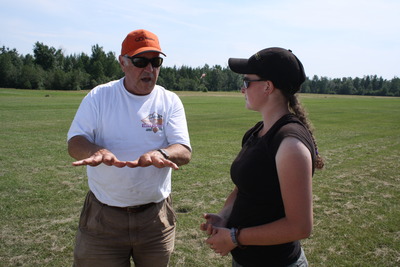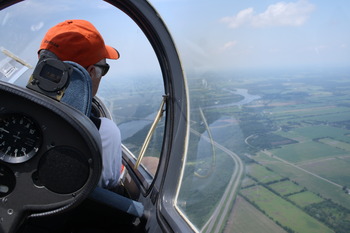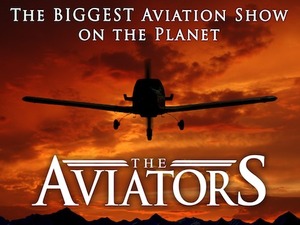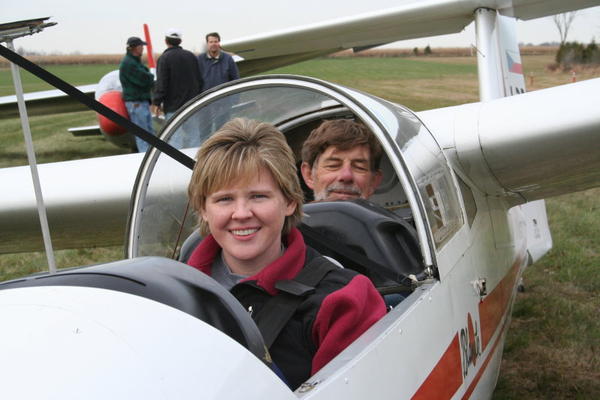An Affordable Way to Get In the Air
Learning to soar is one of the least expensive ways to learn to fly. The gliders are club-owned and are simple to maintain, compared to powered aircraft. Because fuel is only consumed during the launch, the cost of flying a glider is much lower per-hour than flying a motorized aircraft. Training costs are kept low because our instructors are unpaid volunteers who simply enjoy the rewards of introducing new people to the joy of soaring. At a gliding club, everyone pitches in to help.
If you are interested in learning to soar, the first step is to visit your local gliding club. Most clubs offer introductory flights where you can experience the joy of soaring flight for the first time. When your introductory flight leaves you craving more, the next thing is to formally join the club's training program. When you join a gliding club, you can expect to pay a membership fee upfront. The costs thereafter are the fees for glider use and launching. Many clubs offer packages which reduce the fees for members who fly frequently, or limit the maximum charge when flights last a number of hours. The joining costs are set by the clubs and the fees reflect the cost of providing facilities, insurance and equipment. Most clubs provide fee information on their websites.
Your Training

Instructors will continue to monitor your solo progress and fly with you periodically. Typically, a number of instructors will have flown with you and assessed your flying competencies. When your instructor thinks you are ready, you will complete a flight test and will write a Transport Canada examination demonstrating you have the required knowledge. Gliding clubs typically put on ground school classes for their students and those lessons will be instrumental in helping you pass the knowledge portion of the training.
The Basic Requirements

Full license requirements are given by Transport Canada but some helpful figures are:
- A minimum of 6 hours of flight training under the direction and supervision of an instructor
- At least 2 hours of solo flight time, including a minimum of 20 takeoffs and 20 landings
In almost all circumstances, student pilots will train beyond the regulation minimums...and that's not a bad thing!
You can fly solo in a glider at the age of 14 but you must be at least 16 to obtain a glider pilot license.
A Lifetime of Challenges
While learning to fly gliders is a challenge in and of itself, the rewards and personal achievements do not end with your newly minted glider pilot license. Gliding offers a lifetime of challenges and it's the lifelong challenge that keeps people from all walks of life in the air. Very early in your training and post license, you will hone your thermalling skills and learn to keep your glider flying for many hours. Once you have perfected the art of thermalling and can comfortably keep a glider airborne using only rising columns of air as your "fuel", new challenges await as you will begin to venture further away from your home airport. This aspect of gliding is known as cross-country soaring. Initial cross-country flights will take you no more than 50 kilometers from your home airport, but for those that have never been far from home it may feel more like a thousand.
As experience is gained, flights of three, four and even five hundred kilometers become the norm. Internationally recognized soaring badges can be obtained by any glider pilot that completes a series of escalating milestones starting with the Silver Badge and culminating with the highest accolade of the soaring community, the Diamond Badge. For those that enjoy the thrill of competition, gliding contests are a great way to test your cross-country flying skills against your peers as you race around a set course. The fastest person around the course, using only the rising updrafts provided by mother nature is the winner! Beyond cross-country flying, you may also enjoy taking friends and family for glider flights. For the truly adventurous there is aerobatic flying. If you want to give back, you can become an instructor.
Get Started Today by Visiting your Local Gliding Club
A full list of clubs in Canada can be found here. All of them provide instruction and can get you started towards your goal of learning to fly.
One Person's Introduction to Soaring
 This excellent feature on gliding by the popular aviation TV show "The Aviators" gives a first hand account of gliding and was filmed at York Soaring near Toronto. Don't worry - aerobatics is not part of basic training!
This excellent feature on gliding by the popular aviation TV show "The Aviators" gives a first hand account of gliding and was filmed at York Soaring near Toronto. Don't worry - aerobatics is not part of basic training!
"Charles, I have a whole new respect for glider pilots. You guys know how to fly" ANTHONY NALLI


